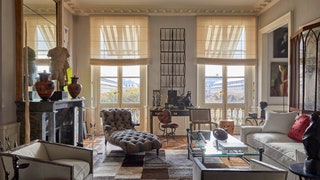All products are independently selected by our editors. If you buy something, we may earn an affiliate commission.
The renovation of Jacques Grange's Parisian apartment in the Palais Royal
Jacques Grange has been a transformative force in the world of interior decoration for decades. Celebrated for his talent for blending elegance with ease, the French decorator has drawn a loyal clientele ranging from European royals to international jet setters. His work effortlessly combines antiques with contemporary pieces, crafting spaces that feel curated rather than designed.
Yet, for someone accustomed to crafting personalised interiors for the most discerning clients, Grange’s Parisian residence presented a different challenge. Since moving in during the early ‘90s, he has reimagined the flat on the first floor of the Palais Royal a few times, balancing his desire to make the space his own with a respect for its storied past (it was famously the last home of the writer Colette).
Grange sensed it was time to pen a new, more personal chapter when the apartment above his became available a few years ago. With picture-perfect views of the exquisite gardens by André Le Nôtre and the distant Montparnasse Tower, it offered the benefit of much-needed extra space and a blank canvas to experiment without being tied to the place’s history. Grange did not hesitate for a moment.
Lightness and comfort guided the renovation. A muted palette of oyster shell greys replaced the earlier weighty colour scheme, paying homage to the eighteenth-century architecture of the Palais Royal. This subtle shift brightened the interiors, enhancing the classical details and creating a neutral backdrop for contemporary touches. Grange also reimagined the flow of the space, inviting natural light to pour into the rooms from both sides of the building.
At the heart of the renovation is the sculptural staircase that now links the living area on the piano nobile with the private rooms above. Inspired by Man Ray’s spirals and Le Corbusier’s staircase for Charles de Beistegui’s penthouse on the Champs-Élysées, it stands in striking contrast to the flat’s classical proportions. Like the engine of a finely tuned machine, the staircase energises the space without overpowering it.
The décor distils Grange’s aesthetic, with furniture and artworks from different styles and eras coexisting as though they have always belonged together. Like any great collection, each piece reveals something intimate about the collector, speaking in this case about those of who have shaped Grange’s personal and professional journey.
A series of photographic portraits of Marie-Laure de Noailles by artists like Man Ray and Dora Maar pays tribute to the visionary patroness of the arts, whom Grange befriended early in his career and regards as his true mentor. An academic study of a male nude by Théodore Géricault, once displayed in Yves Saint Laurent’s apartment, serves as a poignant reminder of Grange’s enduring friendship with the fashion designer and his partner Pierre Bergé, for whom he designed extraordinary homes around the world.
Cherished pieces like a 19th-century Neo Gothic screen and Claude Lalanne’s whimsical ‘Choupatte’ still grace the flat. Still, contemporary additions such as a bright red console table by Hervé van der Straeten in the entrance hall and a sleek grey marble table by Marc Newson bring fresh dynamism to the interior, reflecting Grange’s cosmopolitan and ever-evolving taste. ‘I wanted the place to feel modern and light,’ the decorator notes, ‘without being contemporary in a cliché way or tied to any specific style. To me, decoration is all about unearthing the elective affinities between objects, even when they seem dissonant at first sight.’
The renovation offered Grange the opportunity to turn each space into an expression of his informed vision. In the master bathroom, he juxtaposed dramatic elements like a marble head by symbolist artist Adolfo Wildt and illustrations by Saint Laurent against a luxurious backdrop of palissandro marble.
When international photographer Ricardo Labougle began considering a book on Parisian interiors, Grange’s flat naturally came to mind. Their longtime friendship allowed him to capture the space in a deeply personal way. Reflecting on their bond, Labougle recalls: ‘I met Jacques Grange a few years ago when I photographed his house in Comporta. Jacques draws on his vast experience and sense of beauty in a way that defies the passage of time. Capturing any of the spaces he creates transports you to another dimension, allowing you to grasp the harmony and elegance of his timeless and unique vision.’
For Labougle, whose lens has captured some of the world’s most exceptional houses, photographing this unique space held a special resonance. ‘Witnessing the Palais Royal bathed in sun, storm, and heavy rain all on the same autumn day was both challenging and beautiful,’ he reflects.
True to Grange’s gift for creating enduring interiors, the latest incarnation of his Parisian home embraces change in harmony with continuity. The tufted chaise longue where Colette once entertained still anchors a sense of legacy, yet now the flat fully embodies Grange’s present. ‘I have lived here for many years, but this renovation allowed me to infuse more of myself into the space. It’s a home that preserves the essence of its past while thoughtfully looking ahead.’
